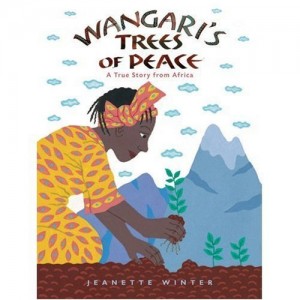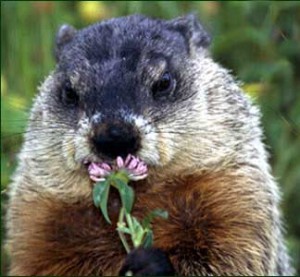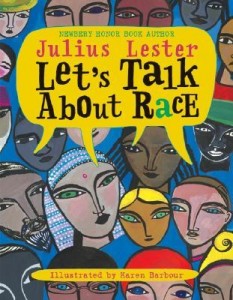My favorite Earth Day book: Wangari’s Trees of Peace
 Sometimes I fear that I can’t make a real difference in helping the planet, but Wangari’s Trees of Peace: a true story from Africa by Jeanette Winter shows how powerful one person’s actions can be. Wangari Maathai was devastated to see how barren Kenya was after thousands of trees were cleared. Soil was eroding and crops wouldn’t grow. The birds were gone. Women walked for miles to gather firewood. “I can begin to replace some of the lost trees here in my own backyard – one tree at a time.”
Sometimes I fear that I can’t make a real difference in helping the planet, but Wangari’s Trees of Peace: a true story from Africa by Jeanette Winter shows how powerful one person’s actions can be. Wangari Maathai was devastated to see how barren Kenya was after thousands of trees were cleared. Soil was eroding and crops wouldn’t grow. The birds were gone. Women walked for miles to gather firewood. “I can begin to replace some of the lost trees here in my own backyard – one tree at a time.”
Wangari started with nine seedlings, which grew into a nursery. Wangari gave new seedlings to village women for them to plant, and gave them money to keep those trees thriving. When Wangari tried to stop the clearing of old trees, she was beaten and arrested. But her message of caring for the Earth was taking root just like her trees were, and because of her, Kenyan women planted over 30 million trees, saving their land and making life there better.
For Earth Day/Arbor Day/natural resources units/biography units/non-fiction read-alouds that you can finish in one sitting, this is my new go-to book. Just by reading it and discussing it with students, you’re hitting the Common Core Standard of Range of Reading (a biography that teaches science and social studies? Non-fiction score!) Wangari’s Trees of Peace is also excellent for an ecological cause-and-effect lesson, one of the big pieces of Key Ideas and Details. Using the book for reference, students can write and draw the effects of deforestation (crops wouldn’t grow, birds were gone, lack of firewood) and the effects of planting all those trees (women don’t have to walk so far to gather firewood, more birds, crops growing in the soil.) Winter’s picture book doesn’t delve deeply into the science of why a lack of trees leads to soil erosion, so you can share Planting the Trees of Kenya: the story of Wangari Maathai by Claire A. Nivola if you need to build that knowledge with your students. Use both books as resources for student writing and drawing, and now you’re Integrating Knowledge and Ideas!
If in the past you’ve received more apple-themed coffee mugs than you need as end-of-the-year teacher gifts, you can suggest that in lieu of a present for you, students can give a gift to us all by planting a tree. If you can spring for a seedling or if your parent-teacher organization will chip in, plant a tree with your students and let them help take responsibility for watering it (seeds are cool, but watering a visible seedling is way more exciting than watering a patch of dirt.) Wangari’s Trees of Peace may plant in your students a dedication to care for our planet.
Read More
Two Perfect “Picks” for Valentine’s Day: Porcupining and Hokey Pokey
This Valentine’s Day, I’d like to share with the readers I love (you!) some of the things I love: wonderful pun-packed picture books by my author-crush Lisa Wheeler and free, already-planned activities to make teaching those books super-easy.
Porcupining: a Prickly Love Story and Hokey Pokey: Another Prickly Love Story, both written by Lisa Wheeler and illustrated by Janie Bynum, feature one of my most-beloved picture book characters, Cushion the Porcupine. We first meet Cushion in Porcupining where he is looking for love in all the wrong places. This forlorn hero of the petting zoo finally finds true love with Barb, a hedgehog. Then, in Hokey Pokey, Cushion wants to make his beloved Barb happy by learning to dance. Asking a fox, a rabbit, and a chicken for dance lessons only leads to prickly situations, and once again Cushion seems stuck out of luck. But Barb proves to be the perfect pick for Cushion when she teaches him all the moves he needs, and together they dance the Hokey Pokey.
 Comparing and contrasting two stories with the same characters, same author, and/or same illustrator is a great way to teach the Common Core State Standard of Integrating Knowledge and Ideas. On her website lisawheelerbooks.com, Lisa has a free teacher’s guide to go with these books. Use the graphic organizer from the teacher guide for Porcupining (written by super-cool author Tracie Vaughn Zimmer) to compare the main character, the problem, the three ways the character tries to solve the problem, and the solution in both books. Then, print off the adorable recipe cards for Cushion Cookies (made by another super-cool author Hope Vestergaard) and your Valentine’s Day is set!
Comparing and contrasting two stories with the same characters, same author, and/or same illustrator is a great way to teach the Common Core State Standard of Integrating Knowledge and Ideas. On her website lisawheelerbooks.com, Lisa has a free teacher’s guide to go with these books. Use the graphic organizer from the teacher guide for Porcupining (written by super-cool author Tracie Vaughn Zimmer) to compare the main character, the problem, the three ways the character tries to solve the problem, and the solution in both books. Then, print off the adorable recipe cards for Cushion Cookies (made by another super-cool author Hope Vestergaard) and your Valentine’s Day is set!
My Book!
 Every week, I write about a terrific picture book to read aloud to students along with a lesson plan or an extension activity. I am jump-up-and-down, wave-my-arms-like-Kermit-the-Frog excited to finally be able to write about my picture book!
Every week, I write about a terrific picture book to read aloud to students along with a lesson plan or an extension activity. I am jump-up-and-down, wave-my-arms-like-Kermit-the-Frog excited to finally be able to write about my picture book!
The title is To See Or Not To See. It’s the story of Groundhog and his dilemma on February 2nd. Half of his friends want him to see his shadow so that winter will last six more weeks. Half of his friends don’t want him to see his shadow so that spring will come early. What will Groundhog do? You’ll find out in the fall of 2015, when the book will be published by Charlesbridge!
Why such a long time to wait, you ask? I know, I wondered about that myself! But in the publishing world, two years is actually quick to make a picture book. My editor and I (my editor! Squeee!) will need to review my manuscript and decide what descriptions can be taken out because the art will show those details. An illustrator has to be chosen for the book – and I don’t get to do the choosing! In publishing, the author rarely has a say as to who will illustrate the book. It’s up to editors and art directors who know the business to match up the right art style with the words. So, an illustrator has to be picked and given time to work on the illustrations. Most illustrators (like my wonderful husband, Matt Faulkner) take months to make the art for a picture book. After that, the art and the words have to be printed together, ink colors made just right, decisions made about font and layout, marketing and promotional decisions have to be made… it’s quite a process!
I’ll be sharing the details here at kristenremenar.com if you’d like to follow along. I’m hoping to hear within a few weeks who my illustrator will be. I’d love it if my husband is chosen – but can’t imagine how I’d handle knowing that the art for my first book is being made up in my husband’s studio without constantly peeking in!
Thanks to all of you who’ve signed up for my newsletter and read my blog. I love sharing my good news with people who love children’s books as much as I do!
P.S. And, as a bit of glorious synchronicity, I got The Call from my editor about the sale of my first book, my Groundhog story, on my birthday, which is Groundhog’s Day. 🙂
Read MoreLet’s Talk About Race
 “It is time for parents to teach young people early on that in diversity there is beauty and there is strength.” – Maya Angelou.
“It is time for parents to teach young people early on that in diversity there is beauty and there is strength.” – Maya Angelou.
Next Monday we celebrate the birthday of the Reverend Dr. Martin Luther King, Jr. What better way to honor his dream of a nation where our children “will not be judged by the color of their skin but by the content of their character” than with a wonderful children’s book celebrating our differences and our similarities.
Let’s Talk About Race is written by Julius Lester and illustrated by Karen Barbour. “I am a story,” Lester writes. “So are you. So is everyone.” Our race is just one part of our stories. “To know my story, you have to put together everything I am.”
How does your story begin? When were you born, and who is in your family? What is your favorite food, your religion, your favorite color, your nationality? All of these things are a part of our stories. But, “some stories are true. Some are not. Those who say ‘MY RACE IS BETTER THAN YOUR RACE’ are telling a story that is not true.”
Lester goes on to tell a story that is true: if you press your fingers gently below your eyes, you can feel the bone beneath your skin. And if you press gently on a friend’s face, no matter what their skin color, you will feel the bone there, too. “Beneath our skin I look like you and you look like me…” Instead of focusing on the stories we can make up about each other based on eye color, skin color, and hair texture, we can find out the true stories, the rich and complex stories, of each other.
After you read Let’s Talk About Race with your students, talk about race! And talk about all the other wonderful parts of our stories, from favorite foods to hair color to pet peeves. You can make a questionnaire based on all the elements Lester talks about for students to answer. Next, challenge students to find someone else who had the something the same on his or her list. You can integrate this into a math lesson by graphing some of the answers, like eye color, or get out the art supplies and let students make cool representations of themselves. If your students can “identify the main purpose of a text, including what the author wants to answer, explain, or describe”, you’ll hit the Common Core State Standard of Craft and Structure using a book with a truly worthwhile main purpose.
Read More







